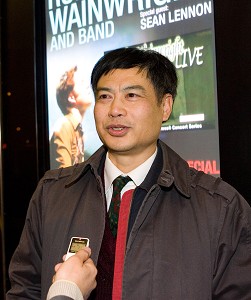(Clearwisdom.net) Mr. Zhou Yanfeng came to the U.S. in the 1990s from China. He currently is the director of the Liaison Department of the Social Democratic Party of China, and also a piano teacher at the New York Chinese Culture Association. He achieved his professional dance training at the Arts Institute of the People's Liberation Army in China. In the 1990s he came to the U.S. to do research in the area of comparison between Western and Eastern cultures at the University of California.
Mr. Zhou Yanfeng, a former professional dancer in China
On the evening of February 7, after he watched the Divine Performing Arts' Chinese New Year Splendor at New York City's Radio City Music Hall, Mr. Zhou said, "This evening's performance has given me a very good impression. The first show I watched was the Holiday Wonders. Today's performance was even better; the cast was even stronger, and the performers were even more professional." He also felt that today's performance had even richer cultural content, a strong cast and powerful expression.
"In the programs, my biggest impression is that over so many years, I have watched many other Chinese New Year performances, but I have not been able to see relatively authentic classic Chinese dances. But I saw them in today's performance. Today when I heard the host and hostess mention Chinese classical dance, I felt very grateful, because once a dancing system is mentioned, people often feel that it means 'ballet.' In fact, Chinese classical dance is also a most complete dance system."
"In terms of pure classical Chinese dance skills, such as hip rotation, the grand goose-shooting, the small goose-shooting, continuously flipping while moving forward and flipping on the same spot, I have not seen people using these skills for many years. Of course, in contemporary dancing, the training has become even more scientific and the skills even more difficult. However, the dancing techniques are for the expression of the content. The dancing in China now has started to become Westernized, and has adopted the Western ballet's ways of expression, which is more open. However, in Chinese culture subtlety is valued. Nowadays, this implicit way of expression is rarely seen. It seems that many of them cannot be seen after the Cultural Revolution."
"This has been seen a lot in today's performance, such as in the dance of Water Sleeves. There is also what the Chinese dance community means about Qifanr [1] such as when a female dancer undulates her body when she walks, turning her body slightly to the right before walking to the left, or moving her body downward slightly before moving her body upward. These things cannot be seen in ballet, in which the body goes directly up or down. So when I watched the Water Sleeves and the Korean dance, I thought that there should be a Mongolian dance, because among the dances performed by males, Mongolian dancing can best reflect the character of man. In the end, I saw the Mongolian Chopstick Zest. So I feel the choreography was extremely good; all types of dances were illustrated. The stage props used in the dances also showed very well. In classical Chinese dance, one requires specific training to use a specific prop, such as fans, handkerchiefs, or targets [using weapons as the props]. This performance seems to have displayed everything."
"Additionally, the combination of dance and modern technology was done very well, which was reflected in the backdrop designs. I do not know how they did it, but the backdrops were very good. Furthermore, they also avoided making each program too long; so the length was just right. It was not overdone, and it still left room for the audiences to imagine. The rhythm in the choreography was also very well done."
Mr. Zhou also mentioned that contemporary dancers may have relatively good muscle training; their figures are good, and they can perform many very difficult movements. However, he felt that contemporary dancers' poise is not that good, while classical Chinese dance emphasizes Fanr [2] and "taste." "Learning dance is different from learning engineering or sports; knowing how to perform a movement does not mean the dancer can dance well. One has passed the exam and mastered the movements, but it does not mean one is an artist. The key lies in the 'Fanr' and if one can master the Fanr. However, today in the girls' dance movements, as well as the Mongolian dance, I have seen a lot of this Fanr. I feel this is very precious. I hope this can let those in the Chinese arts communities reflect on themselves."
Mr. Zhou expressed that, as an overseas Chinese in this environment, he needs to think more of his identity (that is, the culture he belongs to). "I hope all Chinese can realize the importance of preserving their cultures. Our establishing the Chinese Culture Association is also for this purpose." In the long run, it is very important to not allow our own cultural roots to be severed, just as the song "Who Am I" in today's performance indicated. These kinds of things, once lost, will be lost forever. It is not like a collapsed house; if one finds its foundation, one can still restore the construction to the original state. The Chinese culture is very broad and profound. One example is in medicine. Modern medicine has many branches that have already gotten to an impasse; so one has to turn to the holistic view of the East to find the way to solve the problems. Thus, it is very important to keep our cultural heritage.
"Today's performances were well choreographed. The use of colors and the styles were very good. Additionally, this performance has far-reaching impact on the inheritance of the Chinese culture."
Mr. Zhou said, "I have a peculiar feeling. I saw so many children inside the theater today. Children usually like making noise. But even with so many children [there today], they did not make noise. The child behind me [was] still less than one year old--only several months. She just slept, leaning on her mom. I thought this was unusual. Was this a 'miracle' or caused by the energy field?"
In the end, Mr. Zhou added, "There is one more thing. I feel that Chinese people's being able to perform in such high-caliber theaters like Radio City Music Hall is already something that the Chinese people should feel proud of. Many performing groups from China, even those that are first-class in China, often perform in some school auditoriums in Flushing."
Notes:
[1] Qifanr: a special term of traditional Chinese dance, which refers to the dancer gathering the potential right before the formal movement; or the dancer psychologically gives his or her body the motive force before entering the artistic situation, usually takes half a beat in time. That might be a very subtle movement, and it usually takes an opposite direction with the first stage pose.
[2] Fanr: poise or figure expressions that represent special meanings or emotions.
February 8, 2008









